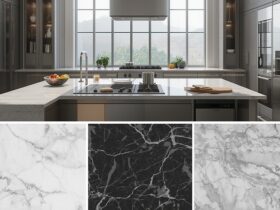Have you ever gazed at a steep garden slope and wondered how to keep everything in place without sacrificing style? Are you curious about clever ways to maximise space on your property while also ensuring safety? If these thoughts have crossed your mind, you’re in the right spot. Retaining walls offer a powerful way to transform uneven landscapes into functional, visually appealing areas.
In this guide, we’ll delve into the world of modern retaining walls and uncover how to balance aesthetic appeal with structural integrity. We’ll look into the core principles behind retaining wall design, plus the cutting-edge innovations taking shape in Australia. Whether you’re a DIY enthusiast or planning to hire a professional, these concepts will help you make informed decisions.

Understanding the Basics
When we talk about a retaining wall, we’re referring to a structure built to hold or retain soil on one side. This means you can have different ground levels on either side of the wall without the soil collapsing. Beyond its practicality, a retaining wall can also become a stunning focal point in your outdoor space.
- What Is a Retaining Wall?
A “retaining wall” is a specially constructed boundary designed to withstand lateral pressure and keep soil in place. While some people picture large concrete or masonry blocks, retaining walls actually come in a range of styles and materials. Options include timber sleepers, concrete blocks, composite retaining wall sleepers, and even natural sandstone. The purpose is always the same: prevent shifting or erosion where the ground slopes or where you want to create tiered levels.
- Why Retaining Walls Are Essential
Retaining walls are essential for ensuring stability in landscapes with varying elevations. They prevent soil erosion and transform otherwise unusable areas into walkways, gardens, or patios. By controlling how soil sits on your property, you can boost not only the visual appeal but also the stability of your land. For many Australian homeowners, installing a structural retaining wall is a practical solution to manage steep sections or create new outdoor living areas.
- Types and Common Uses
Common retaining wall types include gravity walls, cantilever walls, and anchored walls. Each type meets distinct needs for soil heights, land conditions, and design preferences. Meanwhile, everyday uses range from landscaping in residential backyards to commercial or public spaces, where layered gardens or sturdy embankments are needed. Whether you’re using block retaining wall design or classic stone walls, the goal remains to hold back earth efficiently while still presenting an attractive façade.
Retaining Wall Structure and Footings
The integrity of a retaining wall largely hinges on its underlying structure. Even if your wall looks fantastic on the outside, subpar footings or inadequate drainage can spell trouble down the line.
- Key Structural Components
At the core, every retaining wall structure includes a footing or base, a wall body, and drainage. The footing gives the wall stability, anchoring it firmly into the ground. Then you’ve got the main wall material—like concrete blocks, steel posts with sleepers, or sandstone blocks—responsible for holding back the soil. Finally, good drainage ensures that water doesn’t build up behind the wall, as excessive pressure from water can cause bulges or cracks.
- Recommended Footing Depth and Materials
When it comes to retaining wall footing depth, local soil conditions matter. Generally, deeper foundations are recommended for taller walls to combat shifting soil. Concrete footings reinforced with steel rebar often work best for block retaining wall design and structural retaining wall projects. In areas with sandy or unstable soil, you might need additional rock or geotextile layers to support the wall. Whatever design path you choose, always confirm you’re following Australian standards retaining walls guidance to keep everything safe and secure.
- Drainage and Waterproofing Essentials
Drainage is also vital because trapped water increases the load behind the wall. Strategically placed agricultural pipes or strips of gravel along the base can direct water away. For instance, composite sleepers in Australia come with recommended drainage guidelines that help prolong their lifespan. Waterproofing membranes applied to the back of the wall can reduce issues with water intrusion, which are especially key if you’re dealing with materials like timber. All these steps help keep your retaining wall stable for years, even in heavy downpours.

Core Design Approaches
Once you understand the basics, you can explore different design approaches that cater to your taste, budget, and site requirements. Each method—whether you’re working with timber, composite, block, or stone—comes with pros and cons that you can carefully weigh.
- Sleeper Retaining Wall Design Guide
A sleeper retaining wall design guide often covers basic timber or green-treated wood sleepers. But new options, like composite retaining wall sleepers, have entered the market. Timber sleepers are classic and give a natural look, yet they require regular maintenance to prevent rotting. Meanwhile, composite designs blend wood fibres, plastic, or other sustainable materials to create a lower-maintenance alternative. Whichever route you choose, correct installation, including sturdy posts and the right footing depth, is essential for structural retaining wall success.
- Composite Retaining Wall Sleepers (Composite Sleepers Australia)
Composite sleepers Australia offers can be a game-changer if you want a balance of durability and style. They’re often resistant to termites and rot, making them perfect for soggy or humid regions. Another benefit is that composite materials are usually lighter than concrete or stone, making handling easier. Plus, they can mimic the appearance of timber without requiring frequent sealing or oiling. If you like the look of wood but want a design that’s low on upkeep, composite sleepers slot in perfectly.
- Block, Sandstone, and Retaining Stone Wall Design
If you’re aiming for a more stately or traditional vibe, block retaining wall design is a solid choice. Concrete blocks interlock and form a sturdy, straightforward foundation. On the other hand, sandstone retaining wall design adds a touch of rugged elegance, reflecting Australia’s natural landscape. Another option is a retaining stone wall design using natural stones or rock to create a rustic, earthy effect. All three choices provide durability, but factor in your area’s soil composition, weather exposure, and required maintenance before deciding.
Ongoing Maintenance and Restoration
A retaining wall’s job doesn’t finish once construction wraps up. Like any built structure, retaining walls benefit from periodic checks to ensure everything stays safe and looks good.
- Identifying Signs of Failure
Keep an eye out for cracks, bulges, or leaning sections, as they suggest something’s amiss with the wall or the soil behind it. If you see excessive water seepage, that might point to clogged drainage. Loose or crumbling mortar in a block or stone wall also indicates potential deterioration. By inspecting your retaining wall regularly, you can catch problems early and avoid costly repairs.
- Repairing and Strengthening Existing Walls
If you spot minor cracks, you may be able to seal them to prevent water infiltration. For significant damage, reinforcing rods or additional anchors might be needed. In some instances, partial rebuilding is required, particularly if the wall suffers from inadequate footings. Consulting structural engineering professionals can be a good call for big repairs. They can confirm that your retaining wall structure meets or exceeds Australian standards for retaining walls expectations and help you prevent further issues.
- Regular Maintenance Best Practices
Simple tasks, like clearing debris from drainage outlets and trimming any roots that might damage the wall, go a long way. If you use timber sleepers, apply protective coatings or stains as recommended. For composite sleepers, a quick wash can keep them looking sharp. If you have a green retaining wall, regular watering and pruning help maintain plant health. Following these straightforward habits ensures that your retaining stone wall design or block-based setup remains both stable and visually stunning.
Conclusion
Retaining walls play a vital role in shaping our landscapes and keeping soil secure. From the foundational footing depth to the final choice of material, every decision matters. By paying close attention to drainage and following Australian standards such as AS4678, you create a long-running solution that stands strong through all kinds of Aussie weather.
Whether you’re drawn to the classic look of stone, the clean lines of concrete blocks, or the durability of composite sleepers, the key is choosing a design that aligns with your property’s needs and your personal style. Remember to factor in council regulations, as ignoring them can bring unwanted issues down the road. Maintaining your wall over time—clearing drains, repairing cracks, and monitoring for any bulges—will only extend its life.










Leave a Review